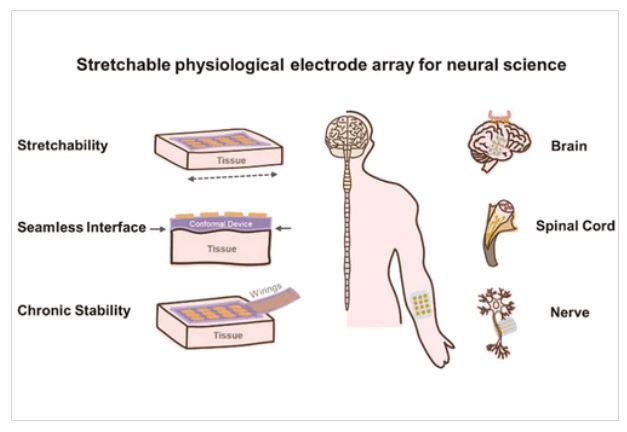Publication
- Interfacing Neuron-Motor Pathways with Stretchable and Biocompatible Electrode Arrays

In the field of neuroscience, understanding the complex interactions within the intricate neuron-motor system depends crucially on the use of high-density, physiological multiple electrode arrays (MEAs). In the neuron-motor system, the transmission of biological signals primarily occurs through electrical and chemical signaling. Taking neurons for instance, when a neuron receives external stimuli, it generates an electrical signal known as the action potential. This action potential propagates along the neuron’s axon and is transmitted to other neurons via synapses. At the synapse, chemical signals (neurotransmitters) are released, allowing the electrical signal to traverse the synaptic gap and influence the next neuron. MEAs can provide unparalleled insights into neural signal patterns when interfacing with the nerve systems through their excellent spatiotemporal resolution. However, the inherent differences in mechanical and chemical properties between these artificial devices and biological tissues can lead to serious complications after chronic implantation, such as body rejection, infection, tissue damage, or device malfunction. A promising strategy to enhance MEAs’ biocompatibility involves minimizing their thickness, which aligns their bending stiffness with that of surrounding tissues, thereby minimizing damage over time. However, this solution has its limits; the resulting ultrathin devices, typically based on plastic films, lack the necessary stretchability, restricting their use to organs that neither stretch nor grow.
Researcher/Author:
Zhi Jiang, Ming Zhu, and Xiaodong Chen
Published in:
Accounts of Chemical Research (ACS Publications), 18 July 2024
To download the paper, please proceed to:
DOI: https://pubs.acs.org/doi/10.1021/acs.accounts.4c00215
- Home
- Interfacing Neuron-Motor Pathways with Stretchable and Biocompatible Electrode Arrays
Singapore Hybrid-Integrated Next-Generation μ-Electronics (SHINE) Centre
- Block E6, #E6-5-3, 5 Engineering Drive 1, Singapore 117608
- +65 6601 8522
- shine@nus.edu.sg

